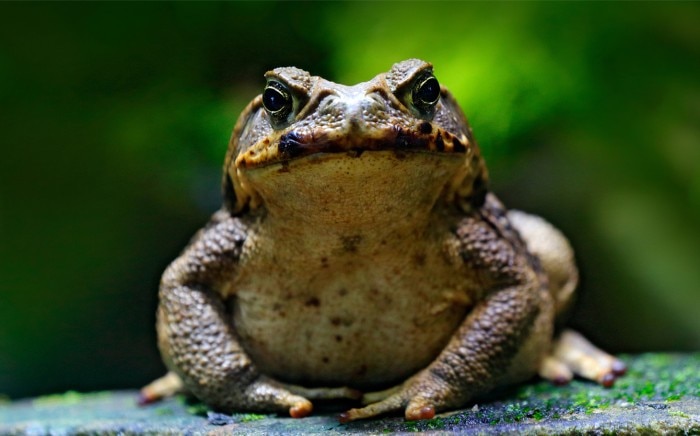MENU
SK | EUR
SK | EUR
No results found
Search Suggestions

Neozoa - They’ve Come to Stay
Explore Life Science
- Off the Bench
- Exploring Life
The cane toad, the brown tree snake or the common starling: animals which expand their habitats beyond their native environment are known as neozoa. Neozoa are considered invasive if they spread without limitation and thus endanger the local ecosystem. In most cases, humans are responsible.
AUSTRALIA
The cane toad: scourge with a warty skin
Approximately 90 years ago, there was not a single toad in Australia; today, Down Under is afflicted by a plague. In 1935, 100 cane toads (Rhinella marina) were brought to Australia from Central and South America – in the hope that they would eradicate the pests in the sugar cane fields. Cane toads, however, proved useless for this task; instead, they became a menace in their own right. The size of a small dog, they jumped out of the plantations and, while exploring their new home, proceeded to devour snakes, lizards, rats, mice and birds. If they themselves ended up as prey, their predators would succumb to their venom. These toads, which have a life span of approximately 40 years, with an impressive procreation rate of up to 35,000 eggs per female, have over time developed even longer legs which allow them to jump even farther and thus spread even more effectively. In order to stop them, scientists had traps installed and came up with countless methods aimed at limiting their procreation. To no avail. They saw a glimmer of hope as they fed sausages made from cane toads to local animals. This offensive, but not deadly, meal was intended to teach the animals that cane toads are an inedible prey. According to a study by the Cane Toad Coalition, the animals thus instructed indeed gave the invaders a wide berth rather than chasing them.
Approximately 90 years ago, there was not a single toad in Australia; today, Down Under is afflicted by a plague. In 1935, 100 cane toads (Rhinella marina) were brought to Australia from Central and South America – in the hope that they would eradicate the pests in the sugar cane fields. Cane toads, however, proved useless for this task; instead, they became a menace in their own right. The size of a small dog, they jumped out of the plantations and, while exploring their new home, proceeded to devour snakes, lizards, rats, mice and birds. If they themselves ended up as prey, their predators would succumb to their venom. These toads, which have a life span of approximately 40 years, with an impressive procreation rate of up to 35,000 eggs per female, have over time developed even longer legs which allow them to jump even farther and thus spread even more effectively. In order to stop them, scientists had traps installed and came up with countless methods aimed at limiting their procreation. To no avail. They saw a glimmer of hope as they fed sausages made from cane toads to local animals. This offensive, but not deadly, meal was intended to teach the animals that cane toads are an inedible prey. According to a study by the Cane Toad Coalition, the animals thus instructed indeed gave the invaders a wide berth rather than chasing them.
Read more
Read less
DEUTSCHLAND
The Chinese mitten crab: nuisance or delicacy? The Chinese mitten crab (Eriocheir sinensis), with its claws reminiscent of woolen mittens, originates from China and Korea. Brought to Germany by cargo ships, it has spread predominantly along the North Sea coastline. There, as well as in the Baltic Sea and the Elbe River, it digs up the ground underwater and thus inflicts damage to dikes and riverbanks. It also destroys fishing nets. In Germany alone, these invasive crabs are said to have caused damages worth 80 million euros. For this reason, researchers at the Leibniz Institute for the Analysis of Biodiversity Change are suggesting reducing the population of the mitten crab within the European Union by approving it as a food. This could work as the crab is considered a delicacy in East and Southeast Asia.
Read more
Read less
USA
The common starling: for the love of ShakespeareIn Germany, the common starling (Sturnus vulgaris) is listed as an endangered species. In contrast, in the US, it is considered a scourge. The culprit, with respect to the invasion of the starling in the US, was a Shakespeare fan: In 1890, Eugene Schieffelin released sixty starlings imported from England in New York’s Central Park. It was his intention to bring all the bird species mentioned in Shakespeare’s works to North America. These days, between 150 and 200 million starlings are raiding the corn fields, orchards and vineyards of America, and they transmit diseases such as toxoplasmosis. As early as 1931, the US Department of Agriculture published a recipe for the culinary preparation of starling breast in order to advertise the bird as a delicacy and thus limit its population. Without success.
The brown tree snake: spiders are delighted
As stowaways on board a military transport plane, specimens of the brown tree snake (Boiga irregularis) flew from New Guinea to the US island territory of Guam in the Pacific, roughly 70 years ago. The reptiles slithered out of the hold of the plane and proceeded to slowly eat their way through the local fauna. Since then, the brown tree snake has exterminated ten of the twelve native species of bird and significantly diminished the populations of fruit bats, lizards and bats. This triggered a chain reaction: the absence of birds left spiders without their natural predators which, in turn, allowed their populations to explode. Furthermore, the seeds of the fruit trees are no longer efficiently spread by birds and fruit bats. The rainforest no longer grows. In order to stop this plague of snakes, scientists are attempting to kill them via mice prepared with poison.
The brown tree snake: spiders are delighted
As stowaways on board a military transport plane, specimens of the brown tree snake (Boiga irregularis) flew from New Guinea to the US island territory of Guam in the Pacific, roughly 70 years ago. The reptiles slithered out of the hold of the plane and proceeded to slowly eat their way through the local fauna. Since then, the brown tree snake has exterminated ten of the twelve native species of bird and significantly diminished the populations of fruit bats, lizards and bats. This triggered a chain reaction: the absence of birds left spiders without their natural predators which, in turn, allowed their populations to explode. Furthermore, the seeds of the fruit trees are no longer efficiently spread by birds and fruit bats. The rainforest no longer grows. In order to stop this plague of snakes, scientists are attempting to kill them via mice prepared with poison.
Read more
Read less
USA and EUROPE
The red lionfish: curse of the Caribbean – and the Adriatic Sea
Originally, this beautiful fish with its colorful stripes and long spikes was native to the oceans between Malaysia and Japan. However, it is suspected that it was aquarium owners who released the first specimen of the red lionfish (Pterois volitans) off the East Coast of America. Since they eat all fish and crustaceans and produce approximately two million eggs every four days, the population of the red lionfish has been expanding rapidly in the Caribbean, driving back the original occupants of the reefs. At the same time, the devil firefish (Pterois miles), starting from the Red Sea, has been heading for the Adriatic by way of the Suez Canal. Due to rising ocean temperatures, scientists are doubtful that the expansion of this warmth-loving species can be brought to a halt. A dark prognosis.
Originally, this beautiful fish with its colorful stripes and long spikes was native to the oceans between Malaysia and Japan. However, it is suspected that it was aquarium owners who released the first specimen of the red lionfish (Pterois volitans) off the East Coast of America. Since they eat all fish and crustaceans and produce approximately two million eggs every four days, the population of the red lionfish has been expanding rapidly in the Caribbean, driving back the original occupants of the reefs. At the same time, the devil firefish (Pterois miles), starting from the Red Sea, has been heading for the Adriatic by way of the Suez Canal. Due to rising ocean temperatures, scientists are doubtful that the expansion of this warmth-loving species can be brought to a halt. A dark prognosis.
Read more
Read less

